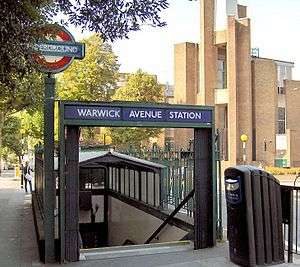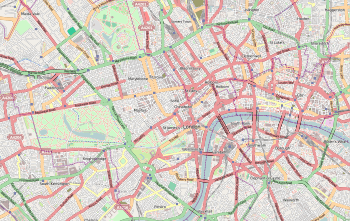Warwick Avenue tube station
| Warwick Avenue | |
|---|---|
 | |
 Warwick Avenue Location of Warwick Avenue in Central London | |
| Location | Little Venice |
| Local authority | City of Westminster |
| Managed by | London Underground |
| Number of platforms | 2 |
| Fare zone | 2 |
| London Underground annual entry and exit | |
| 2012 |
|
| 2013 |
|
| 2014 |
|
| 2015 |
|
| Railway companies | |
| Original company | London Electric Railway |
| Key dates | |
| 31 January 1915 | Opened |
| Other information | |
| Lists of stations | |
| WGS84 | 51°31′24″N 0°11′01″W / 51.523270°N 0.183677°WCoordinates: 51°31′24″N 0°11′01″W / 51.523270°N 0.183677°W |
|
| |
Warwick Avenue is a London Underground station near Little Venice in inner north-west London. The station is on the Bakerloo line, between Paddington and Maida Vale stations, and is in Travelcard Zone 2.
History
Warwick Avenue opened on 31 January 1915 on the Bakerloo tube's extension from Paddington to Queen's Park.[2]
The ticket hall and its ticket machines were destroyed by fire overnight on 17 September 1985, causing the station to be closed for the day.[3]
Location and layout
The station is located at the junction of Warwick Avenue, Warrington Crescent and Clifton Gardens. For a time prior to its opening, the proposed name for the station was Warrington Crescent.[4]
There is no surface building and the station is accessed by two sets of steps to a sub-surface ticket hall. It was one of the first London Underground stations built specifically to use escalators rather than lifts.[5] A plain, utilitarian brick ventilation shaft has been built on the traffic island in the middle of the road to improve ventilation of the tunnels.
Connections
London Bus Routes 6, 46, 187 and 414 serve the station.
A regular waterbus service runs from nearby Little Venice along the Regent's Canal; during the summer months boats depart hourly towards London Zoo and Camden Lock.
In popular culture
The song "Warwick Avenue" by Welsh singer Duffy makes reference to the station.[6]
Gallery
- Northbound platform looking south
- Southbound platform looking north
 Ticket office
Ticket office- Ventilation tower
References
- 1 2 3 4 "Multi-year station entry-and-exit figures" (XLS). London Underground station passenger usage data. Transport for London. April 2016. Retrieved 3 May 2016.
- ↑ Rose, Douglas (1999). The London Underground, A Diagrammatic History. Douglas Rose/Capital Transport. ISBN 1-85414-219-4.
- ↑ "London Underground Ltd and Rapid Transit: Warwick Avenue Blaze". Journal of the Transport Ticket Society. Luton: Transport Ticket Society (266): 78. February 1986. ISSN 0144-347X.
- ↑ Harris, Cyril M. (2006) [1977]. What's in a name?. Capital Transport. p. 74. ISBN 1-85414-241-0.
- ↑ The first escalator on the Underground was installed at Earl's Court in 1911. The first station built specifically for escalators was the new Central line station at Liverpool Street in 1912. All deep-tube stations built after 1913 were built with escalators – Wolmar, Christian (2004). "Beginning to Make Sense". The Subterranean Railway: How the London Underground Was Built and How It Changed the City Forever. Atlantic Books. pp. 205–206. ISBN 1-84354-023-1.
- ↑ "10 Great Songs about London". The London Helicopter. Retrieved 13 October 2015.
External links
| Wikimedia Commons has media related to Warwick Avenue tube station. |
| Preceding station | Following station | |||
|---|---|---|---|---|
towards Harrow & Wealdstone | Bakerloo line | towards Elephant & Castle |